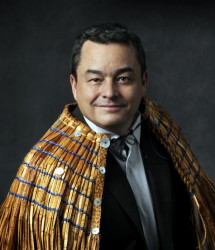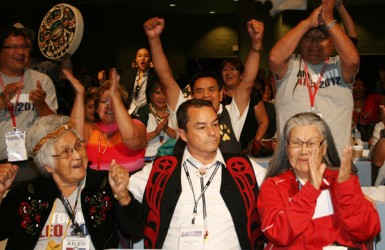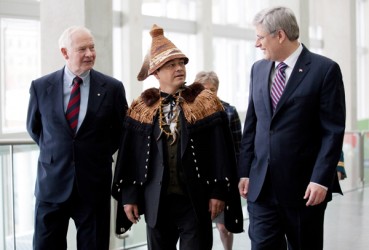Article Origin
Volume
Issue
Year
Six theories on what led to Atleo’s fall
Shawn A-in-chut Atleo’s sudden resignation as Assembly of First Nations national chief on May 2 caught much of the country off-guard. He is the first national chief ever to throw in the towel.
For close observers of Native politics in Canada, however, long-simmering tensions in the organization muted the surprise. For such analysts, the writing was simply on the wall all along.
Atleo’s name A-in-chut means “everyone depends on you.” Over the past year, however, his public appearances had taken an increasingly weary tone. The national chief seemed visibly deflated and spent, finding difficulty mustering the optimistic energy that previously had once earned him admiration and respect. (“We will stand together and put the final stake in colonialism,” he vowed in 2012).
In his resignation speech, the 47-year-old Ahousaht hereditary chief announced he was stepping aside after five years because, “This work is too important, and I’m not prepared to be an obstacle to it, or a lightning rod distracting from the kids and their potential.”
Here are just a few of the top theories circulating about Atleo’s fall from the top First Nations’ office.
1. The First Nations Control of First Nations Education Act
When Atleo stepped down, pledging he didn’t want to be a “distraction” or “lightning rod,” he was specifically referring to federal Bill C-33, the First Nations Control of First Nations Education Act.
The last few months of Atleo’s tenure were spent trumpeting, then defending, the virtues of the bill. Both Atleo and Prime Minister Stephen Harper said the legislation’s purpose was to fix the grossly underfunded on-reserve schools crisis. To the critics, regardless of its billion-dollar funding boost and some limited First Nations’ autonomy over curriculum, the proposed Act was simply a deal with the devil.
Atleo faced open resistance early on from the AFN-Quebec representative, who criticized the deal as not respecting self-determination. Likewise, the head of the Chiefs of Ontario complained his organization hadn’t been adequately consulted.
Soon, organizers with Idle No More were rallying people in the streets, and Atleo’s closest challenger in his re-election race was among the first to openly call for his ouster by the AFN’s more than 630 chiefs.
In an April 28 blog post titled #IMPEACH ATLEO, Ryerson Indigenous Governance Chair Pamela Palmater described the supposedly “historic” education bill as “the deal that no First Nation asked for and its one that Atleo had no power to make.
“It’s historic because not only will Atleo go down in history as the worst National Chief,” the Mi’kmaq scholar wrote, “but he has taken the AFN down with him.”
Now, in the wake of Atleo’s resignation, Aboriginal Affairs Minister Bernard Valcourt has put the controversial bill on ice, but many fear it will resurface and have vowed to fight it — and press for both equal funding with non-Aboriginal school systems, as well as what they see as authentic Indigenous control over their own communities’ education.
2. Mandate overreach and Conservative coziness
While the education bill was the immediate fire that drove Atleo from Ottawa, it was really only the last of a series of hotter and hotter sparks that saw the embattled leader increasingly challenged, both publicly by his detractors and behind closed doors by his own chiefs who elected him.
It was only months after he was re-elected to his second term that Atleo faced a revolt over his decision to meet with Valcourt’s predecessor and Prime Minister Harper at the height of Attawapiskat Chief Theresa Spence’s hunger strike.
Spence’s key demand was to meet face-to-face with the Governor General and Prime Minister. Against the wishes of many chiefs, Atleo wagered that a meeting with only Harper was a historic opportunity that could gain some headway. That decision saw a walk-out of the other invited chiefs, some of the same outspoken figures who shortly before had got in a dust-up with Parliament Hill security over trying to access the chambers.
Atleo’s willingness to sit down with the current Conservative administration, considered regressive by most in Indian Country, confirmed for many of his critics that Atleo’s pragmatism had crossed a moral line.
Atleo’s ill-fated federal meetings saw him accused of speaking for — or worse, negotiating on behalf of — the more than 630 First Nations. That, in the AFN, is a serious no-no, given that the organization was founded (originally as the National Indian Brotherhood) as an advocacy and lobbying group, initially to fight the assimilationist White Paper of 1968.
Atleo has no power to negotiate treaties, hammer out deals, or act on behalf of the larger assembly unless ordered to do so by the larger assembly. So his endorsement of a series of government initiatives, the latest being the federal education bill, was for many what sealed Atleo’s fate.
That path also began long before his Crown meeting during Idle No More, and even before his high-level Crown-First Nations Gathering a year earlier.
3. Pragmatism was simply his style
In 2009, while he was still B.C. AFN regional chief, Atleo found himself in hot water over his endorsement of the BC Liberals’ Recognition and Reconciliation Act, a bill that would have made it easier for the province to engage with larger numbers of band councils at once.
“The legislation represents an achievement for all British Columbians,” he wrote in the Georgia Straight at the time. “While First Nations peoples know that our rights, inherited from our ancestors, are indisputable, we also know that we are all here to stay.
“We have to create a new path to move forward together. We must act on the opportunities this legislation will provide. As First Nations, we seek support and are prepared to work and cooperate with all parties to bring about the Recognition and Reconciliation Act.”
The endorsement attracted controversy from many high-level commenters, who argued that the bill’s push for economic certainty would only benefit non-Indigenous business interests and resource developers, but put at risk the inherent Aboriginal rights foundation which had gained B.C. nations so much success in Canada’s courts.
“There has been a groundswell of opposition by Indigenous peoples to the Recognition and Reconciliation Act,” wrote former Neskonlith chief Arthur Manuel in a Georgia Straight rebuttal to Atleo. “This will undermine Aboriginal title and Indigenous efforts to protect the environment from increased resource exploitation. This has created a backlash against the First Nations Leadership Council.”
It was an early taste of how Atleo’s pragmatic approach to government would clash in his future role at the AFN with those who saw the path to victory in a fiercer assertion of inherent Aboriginal rights.
But according to Concordia University’s School of Community and Public Affairs professor Karl Hele, Atleo’s education bill endorsement undermined the advocacy mandate of AFN’s founding Charter, as well as the National Chief’s subservience to its members.
“Mr. Atleo, and the AFN for that matter, has been acting more like a government for First Nations, rather than as their voice in Ottawa,” the Garden River First Nation member wrote in the Globe & Mail on May 20. “The failure to undertake a consultative process will result in the aboriginal political elite being easily undermined and growing more dependent upon Ottawa for legitimacy in the eyes of Canadians.”
4. Partisan politics
For outspoken Sto:lo Nation senior policy advisor Ernie Crey, all of these theories miss a key factor. For the former head of the United Native Nations Society of B.C., the real issue is politics, pure and simple.
“Many of these key spokespeople within AFN’s upper echelons and at the lower levels are mainstream partisans,” he told Windspeaker. “Most of them are obviously not Conservatives.
“The quarrels, arguments and fights between mainline political parties are mirrored in this dispute over the education bill… It was going to be a centrepiece for Shawn Atleo, it was going to be his legacy. The partisans within the AFN got busy to do everything within their power to deny him and the Conservatives this legacy.”
5. AFN election legacy
While Crey remains convinced that battles between the Liberals and New Democrats have cast their hidden shadows deep inside the AFN, the organization is certainly large enough in size and bureaucracy to carry its own political machineries. And carry them it has.
Many of the factions vying to oust Atleo, those pushing militancy, and some hinting at a run to replace him, are the very factions Atleo faced during his re-election bid. Chief among them are Palmater and the grand chief of the Assembly of Manitoba Chiefs, Derek Nepinak, one of Palmater’s chief campaign backers who led the charge in the Parliament Hill fracas and the January 2013 Crown meeting boycott.
Recall that even though an outsider to band council leadership, Palmater’s bid garnered a significant dissenting chunk out of Atleo’s two-thirds victory. With few of his supporters openly supporting Atleo since, his critics have stepped into that void.
“They’ve never gotten over it,” Crey told Windspeaker. “They’ve put a lot of time and energy in efforts to oust Atleo.
“There’s been an effort to run Atleo out of office for over a year now within the AFN … I think he took a look at it and said, ‘I’ve done my level best — if I stick around I’m going to be the lightning rod for it and there won’t be a resolution to it. My best approach is to resign.’”
6. Divide and conquer
For some observers, Atleo was dealt a losing hand from the start, and doubling down on the results-based approach that elected him was the only route open to him to save face, short of admitting defeat altogether.
As a result of deep federal cuts to the AFN’s budget over recent decades, the organization has struggled to keep afloat and stay relevant, oscillating between leaders dubbed “moderate” or “militant” by the federal government and business community.
Moves towards a more militant approach — in particular, talk of direct action targeting Canada’s economic infrastructure — have been met with a loss of core funding that has severely hampered the organization’s advocacy and weakened its impact.
In that context, some see the ouster of Atleo and the current jockeying to replace him, as symptoms of a much deeper problem that some say has entered at the heart of the AFN itself: the classic colonial game of divide and conquer.
For some analysts, those deep differences reflect the differing interests and tactics of bands in Ontario and the Prairies fighting to uphold their historic treaties, and the larger number in mostly unceded regions such as B.C. advocating for the broader set of inherent Aboriginal rights and title to the land.
Whether the tensions inside AFN continue to play out the historic game of divide and conquer, carrot and stick, remains to be seen. But as Indian Country looks to the future of its largest and most prominent advocacy body, many questions continue to swirl about where it is headed — and whether it can regain its once-powerful voice.
- 6523 views



